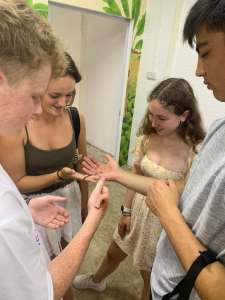Jazmine ’25, learns “the value of self-sufficiency, and how small changes can make a bigger impact later on in our community, if the community collectively works to help one another.”
We passed many plant covered buildings as we traveled to Edible Garden City to learn more about Singapore’s sustainability. We learned about the thirty for thirty plan, Singapore’s plan to be 30% self-sufficient by 2030. We learned beforehand that Singapore has started this plan by trying to up-cycle water and build their own reservoirs instead of buying water from Malaysia.
Singapore is also now trying to produce its own food instead of depending on imported goods from different countries. One such way is by growing microgreens that are grown in Edible Garden City. We munched on basil and enjoyed the different taste each green leaf had to offer from the subtle taste to the slight stingy burn of spice. We learned about food waste and how each individual could work to limit how much trash is wasted by vermicomposting. We saw a vermicomposting bin in action and were enlightened to try and create our own vermicomposting systems in our own home. Some of us got to hold the African earthworms and see them squirm around on our hands as we were awe stricken at the new sight in front of us. We also learned that the government would rent one square meter plot of land to people, who would in return decide to grow a crop. Although Singapore does not have good farming soil, the small plots were well used with many different types of crops all growing together. Overall, we learned the value of self-sufficiency, and how small changes can make a bigger impact later on in our community, if the community collectively works to help one another.





